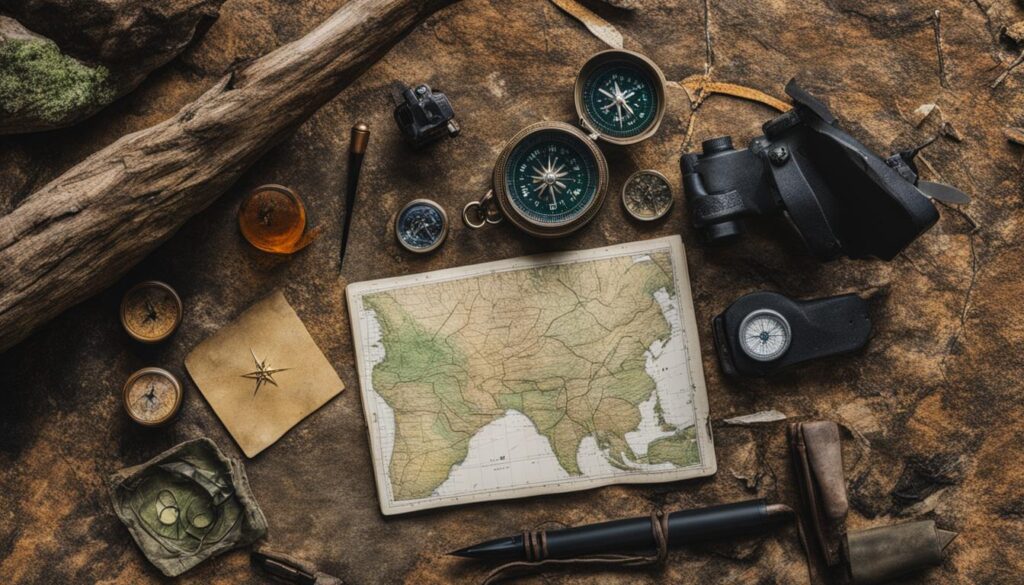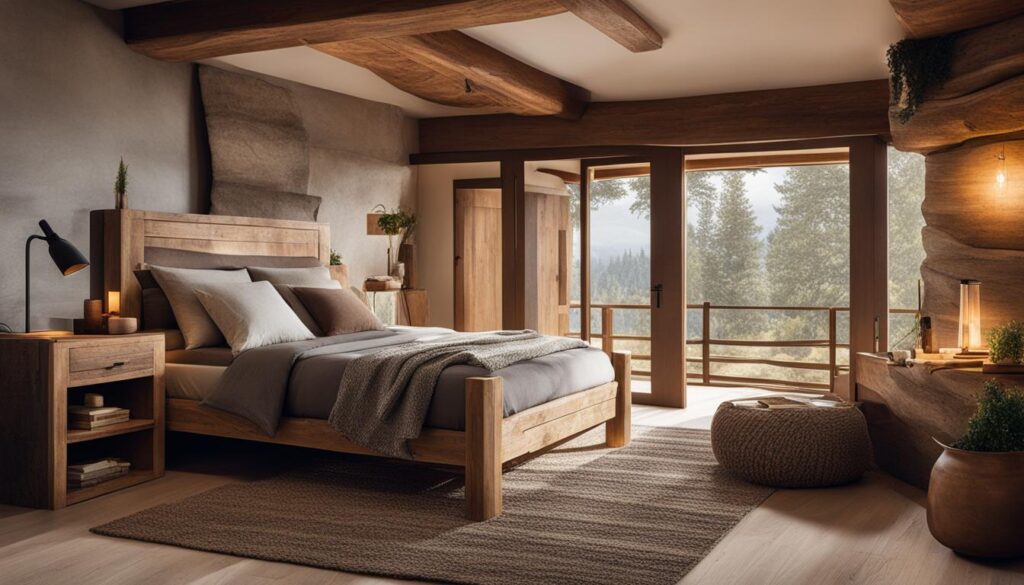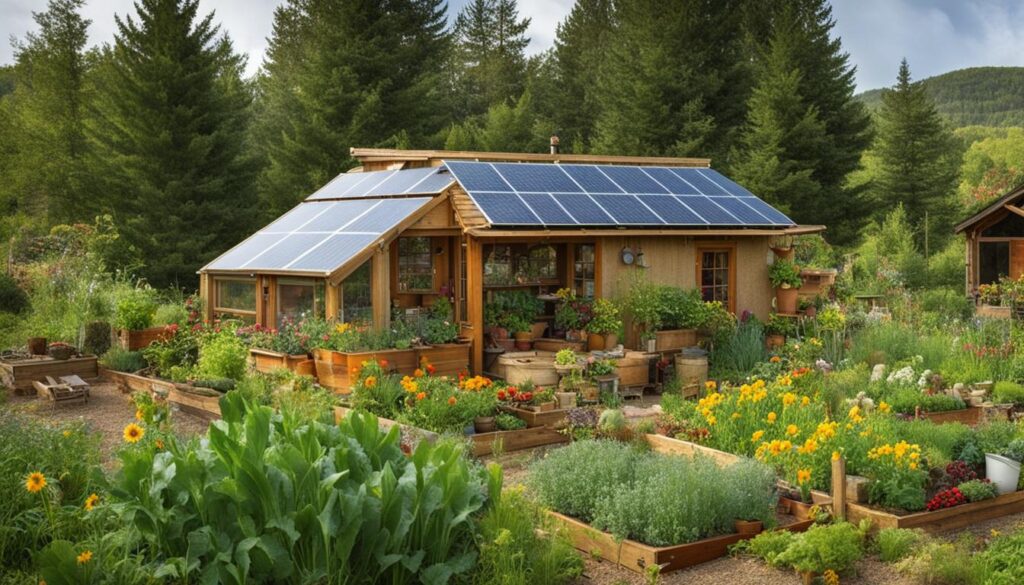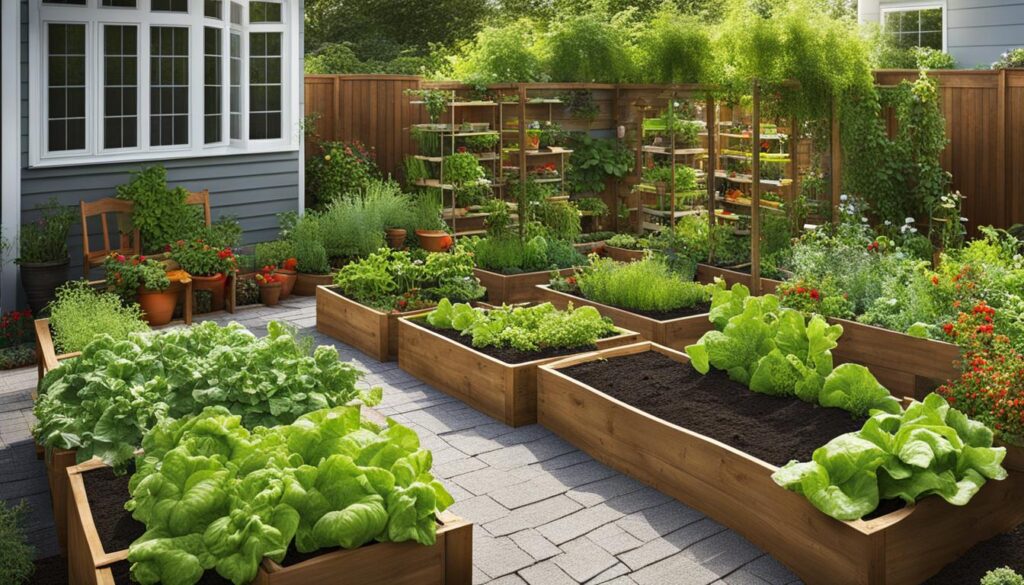
When it comes to homestead security, safeguarding your prepper oasis is crucial for protecting your self-sufficient home and valuable resources. Implementing the right strategies and measures can help prevent looting and ensure the safety of your prepper sanctuary.
Homestead security essentials include installing a privacy fence to deter potential intruders and create a physical barrier around your property. A guard dog can provide an extra layer of protection and serve as an early warning system. Deceptive planting techniques, such as intermixing edible and non-edible plants, can confuse and discourage would-be thieves.
Incorporating poisonous plants is another effective method to keep intruders away. These plants can act as a natural defense mechanism, deterring unwanted visitors from venturing into your prepper oasis. When considering plantings, be sure to research and choose varieties that are native to your region and suitable for your climate.
Electric fences can be an effective means of securing your property. These fences create a strong deterrent and provide a physical barrier, discouraging unauthorized access. Additionally, installing alarms, both inside and outside your home, can alert you to any potential threats and deter intruders.
Consider incorporating additional measures, such as punji sticks and other traps, to further protect your prepper oasis. These devices can be strategically placed around your property to deter and disable intruders. However, it’s important to be mindful of local laws and regulations regarding the use of such devices.
Protecting your garden from wildlife and potential looters is also crucial. Installing a high-quality deer fence can help keep out wildlife that may devastate your crops. Placing motion-activated lights and cameras can serve as a deterrent and help identify any individuals who may attempt to steal your food sources.
By implementing these homestead security measures, you can fortify your prepper oasis and maintain the integrity of your self-sufficient home. Protecting your valuable resources is essential for long-term survival and peace of mind.
Key Takeaways:
- Installing a privacy fence and utilizing guard dogs can deter intruders and create a physical barrier around your property.
- Deceptive planting techniques and incorporating poisonous plants can confuse and discourage potential thieves.
- Electric fences and alarms provide additional security measures to safeguard your prepper oasis.
- Consider using punji sticks and traps, but be mindful of local laws and regulations.
- Protect your garden from wildlife and looters with a high-quality deer fence and motion-activated lights and cameras.
Planning and Budgeting for Your Survival Retreat
Creating a survival retreat requires careful planning and budgeting to ensure it meets your needs and withstands unforeseen circumstances. Consider the purpose of your retreat – is it solely for refuge during disasters or a full-time residence? This will determine the level of preparations needed.
One essential aspect is considering the costs involved in building and maintaining your survival retreat. Costs may vary depending on the size and location of your property, as well as the level of self-reliance you desire. It’s crucial to view these costs as investments in your family’s safety and well-being.
If you’re looking for a cost-effective option, tinyhouse prepper living is worth considering. With careful planning and design, you can maximize space while still ensuring self-sufficiency. On the other hand, larger retreats with multiple rooms and extensive preparations may come with higher costs but provide added comfort and security.
Remember, long-term preparations are necessary for a successful survival retreat.
Consider these factors when planning and budgeting for your survival retreat:
- Assessing the purpose and extent of your retreat
- Calculating costs based on property size and location
- Exploring design options for a prepper house
- Achieving self-reliant living in your retreat
- Gaining insights from the Ultimate Survival System Book
- Evaluating prepper home costs for short-term and long-term sustainability
- Ensuring long-term preparations for extended periods of self-sufficiency
By carefully planning and budgeting, you can create a survival retreat that meets your needs while prioritizing self-reliance and long-term sustainability. Embrace the journey of building your retreat and take pride in the steps you take to protect your loved ones.

Designing Functional Bedrooms in Your Survival Retreat
When it comes to designing the bedrooms in your survival retreat, utility and adaptability should be your top priorities. Consider the number of people you are preparing for and their specific needs. One effective way to maximize space is by using bunk beds, which not only provide extra sleeping accommodations but also create an efficient layout.
Another option to consider is convertible furniture that serves multiple purposes. This type of furniture can transform from a bed to a desk or dining table, saving both space and resources. It adds versatility to your bedrooms and allows you to adapt to various activities and needs.
Comfort is crucial for maintaining high energy levels and positive morale. Proper insulation is key to ensure a cozy and warm environment, especially during harsh weather conditions. Invest in quality insulation materials to keep the bedrooms comfortable and well-insulated.
Incorporate storage solutions to organize personal items and clothing suitable for different weather conditions. This will not only help you stay organized but also optimize the use of space within your bedrooms. Consider using under-bed storage, wall-mounted shelves, or functional furniture pieces with built-in storage compartments.
Privacy is essential, especially in shared spaces. Consider incorporating curtains or room dividers to create a sense of privacy for each individual. This will help everyone feel more comfortable and maintain a healthy level of personal space.
Additionally, integrating hidden compartments can provide extra security for emergency supplies or personal valuables. These hidden compartments can be strategically designed within furniture or walls to ensure that important items are kept secure and out of sight.
Well-designed and functional bedrooms contribute to the overall success of your survival retreat. By prioritizing utility, adaptability, insulation, storage solutions, privacy, and hidden compartments, you can create a space that meets the needs of your family and enhances the overall efficiency of your survival retreat.

| Aspect | Solution |
|---|---|
| Bunk beds | Maximize space and provide extra sleeping accommodations |
| Convertible furniture | Serve multiple purposes and save space |
| Insulation | Ensure comfort and maintain a cozy environment |
| Storage solutions | Organize personal items and optimize space |
| Privacy in shared spaces | Create a sense of privacy with curtains or room dividers |
| Hidden compartments | Provide extra security for emergency supplies or valuables |
Creating Practical Bathrooms in Your Survival Retreat
When it comes to designing the bathrooms in your survival retreat, functionality and cleanliness should be your top priorities. In this section, I will discuss key factors to consider for creating practical and efficient bathrooms that cater to your needs. Let’s delve into the essential elements of survival retreat bathrooms.
Functionality and Water Supply
Functionality is crucial when designing bathrooms in your survival retreat. Alongside prioritizing cleanliness, clean water supply is essential for hygiene, cooking, and drinking. One effective solution to ensure a reliable clean water source is implementing a rainwater harvesting system. This system allows you to collect rainwater and use it for various purposes in your bathrooms, reducing dependency on external water sources.
Waste Management with Composting Toilets
Waste management is another critical aspect to address in your survival retreat bathrooms. Traditional flush toilets require a significant amount of water, which may be limited in survival situations. Consider using composting toilets as an alternative. Composting toilets are designed to reduce water consumption and transform human waste into nutrient-rich compost. They are environmentally friendly, sustainable, and can be a practical solution for waste disposal in your survival retreat.
Ventilation and Comfort
Proper ventilation is essential to maintain a comfortable living environment in your survival retreat bathrooms. Adequate ventilation prevents condensation build-up, which can lead to mold and mildew growth. Consider installing ventilation systems such as exhaust fans or vents that allow fresh air circulation while maintaining privacy and security.
Space Utilization and Storage Solutions
In small bathrooms, space utilization becomes crucial. Maximize the available space by incorporating effective storage solutions. Install shelves or wall-mounted racks to store toiletries, towels, and other necessities in an organized manner. Efficient space utilization ensures that your bathroom remains tidy and functional.
To further illustrate the importance of space utilization and storage solutions, here’s a table showcasing different storage options for survival retreat bathrooms:
| Storage Solution | Description |
|---|---|
| Shelves | Wall-mounted shelves provide vertical storage space for towels, toiletries, and other bathroom essentials. |
| Cabinets | Install floor-standing or wall-mounted cabinets for concealed storage, keeping your bathroom clutter-free. |
| Hanging Baskets | Utilize hanging baskets to store smaller items, such as soap, toothbrushes, and shaving supplies. |
Conclusion
In conclusion, homestead security plays a vital role in protecting your prepper oasis and ensuring the safety of your self-sufficient home. By implementing various strategies such as installing privacy fences, utilizing guard dogs, employing deceptive planting techniques, and utilizing electric fences and alarms, you can safeguard your survival garden from looting and protect your valuable resources.
Additionally, it’s important to consider the practical aspects of your survival retreat, including planning and budgeting, designing functional bedrooms and bathrooms, and incorporating storage solutions. Adequate planning and budgeting are essential for the success of your survival retreat, while well-designed and functional bedrooms and bathrooms contribute to a sustainable living condition.
By focusing on homestead security and creating a well-prepared and secure prepper oasis, you can maintain the integrity of your self-sufficient home and protect it during challenging times. These homestead security takeaways highlight the importance of protecting your self-sufficient home and serve as a wrap-up for the overall discussion on homestead security. Now, armed with these insights and strategies, you are well-equipped to protect your prepper oasis and embrace the self-reliant lifestyle of homesteading.
FAQ
What are some essential homestead security measures?
Essential homestead security measures include installing a privacy fence, using guard dogs, employing deceptive planting techniques, incorporating electric fences and alarms, and considering punji sticks and other traps.
How can I protect my survival garden from wildlife and potential looters?
To protect your survival garden, you can utilize strategies such as installing a privacy fence, using guard dogs, and planting poisonous plants as deterrents. Electric fences and alarms can also be effective in deterring potential looters.
What should I consider when planning and budgeting for my survival retreat?
When planning and budgeting for your survival retreat, consider the purpose of your retreat and the level of self-reliance you desire. Determine the costs involved, which will depend on the size and location of your property and the extent of your preparations.
How can I design functional bedrooms in my survival retreat?
When designing bedrooms in your survival retreat, prioritize utility and adaptability. Consider the number of people you are preparing for and their specific needs. Bunk beds and convertible furniture can maximize space, and proper insulation is crucial. Additionally, incorporate storage options and privacy solutions such as curtains or room dividers.
What are some key considerations for creating practical bathrooms in my survival retreat?
Key considerations for creating practical bathrooms in your survival retreat include ensuring access to clean water, implementing composting toilets for waste management, providing proper ventilation, and maximizing space utilization with storage solutions such as shelves or wall-mounted racks.


